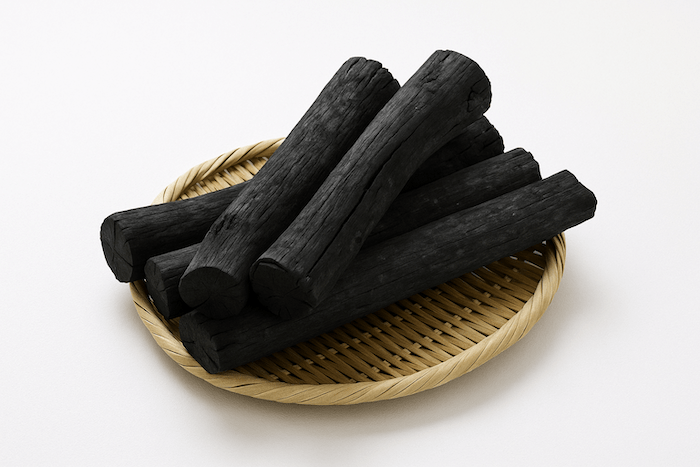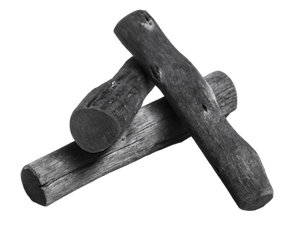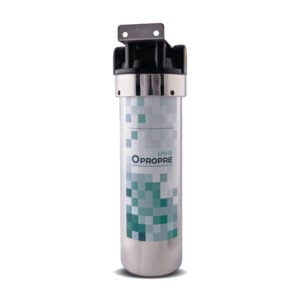
30-day money-back guarantee *
30-day money-back guarantee *

You wish to purify your tap water with binchotan charcoalor the Chinese version made from bamboo charcoal, sold under a wide range of brand names?
Presented as natural, ecological and reusable, the binchotan coal promises to filter contaminants from tap water and improve its taste. But is it really true?
In this article, we take a closer look at this natural purification methodto help you decide whether binchotan charcoal deserves a place in your decanter or whether you're better off with other alternatives.
For those who don't use it, the first thing to do is to explain the exact nature of this particular type of charcoal.
Binchotan carbon is a type of activated carbon. Now, you might ask, "What the hell is activated carbon?
Well, activated carbon is made from organic materials such as wood, coconut shells or sugar residues. It is made by burning these materials at high temperatures, which creates microscopic pores in the charcoal. These pores allow the activated carbon to capture certain impurities in the water. or air (a phenomenon called "adsorption", which is different from absorption).
Activated carbon is often used in the following applications cartridges of your filter jugs for example (But is it effective? See our opinion on the carafe filter).
Le white charcoal binchotan is a type of Japanese activated carbon made from the Japanese ubamegashi holm oak. This oak grows mainly in a region formerly known as the province of Kishu and more specifically in the town of Wakayama (other towns and regions in Japan produce it today).
It is made using a low-temperature combustion process in which wood is burnt in an earthen furnace for several days. This creates very dense, very hard charcoal sticks with a relatively smaller specific surface area than conventional activated carbons, but with a higher adsorption capacity.
Some people therefore consider binchotans to be effective for water and air purification because of their ability to adsorb impurities and odours.
Le Binchotan coal from Kishu is considered to be of the highest quality, thanks to the quality of the wood used and the know-how and experience of local producers.
Now you know (just about!) everything you need to know to continue our discussion.

The binchotan charcoal is undoubtedly a little effective. There is indeed a change in taste, but strangely so, no independent scientific study has proven the real benefits of its use. Did you say bizarre?
What effect does this purification method really have on the heavy metals, pesticides, traces of fertiliser and drug residues contained in tap water?
We will have to make do with manufacturers' claims alone. Curious for a food product, which should be controlled before being put on the market...
Sources that highlight this lack of evidence include this article from L'Express which bears witness not so much the danger of binchotan coal as its uselessness.
Genuine binchotan charcoal is not dangerous in itself. But on the market, most of the products sold under the name of "binchotan charcoal" are dangerous. binchotan "are in fact imitations of uncertain provenance, manufactured by from wood of inferior quality, badly burnt or chemically activated.
They may therefore contain residues of harmful products, or even traces of tar!
And finally.., no study proves that it effectively eliminates heavy metals, pesticides, drug residues, PFAS, etc., unlike other filtration solutions (to be found in our comparative article on water filters). Believing that water is perfectly purified thanks to binchotan is therefore misleading and amounts to exposing your health to harmful contaminants sometimes present in tap water.
💧 Read also : What is the best tap water filter?
I'd like to say yes, just as much as destroying the Amazon rainforests by fire!
Unfortunately, this is oak wood burnt at very high temperatures (from 400 to 1200°C) for dozens of hours (up to 15 days!). This process releases fumesand fine particles and CO2. The final product will then be transported 10,000 km from its place of production, while being wrapped in aluminised plastic for preservation.
It will then redo a few thousand km by lorry to reach the depot or shop before you get home to filter tap water It's anything but sustainable.
The only thing organic about it (apart from the fact that you can find it in organic shops...) is that it is easier to recycle than a carafe filter. It decomposes very well in the soil. But... for the environment, binchotan coal danger !
No way! This sterilisesbut does not regenerate its adsorption capacity. The pores would have to be unblocked in an oven at 1200°C to make it "activated" again.
You are therefore advised to change it regularly, but nobody knows how often. We also don't know how long it will take to purify a certain volume of water.
On the other hand, boiling it once a week is not recommended by some, means a much higher carbon footprint. The choice is yours.
Genuine Japanese binchotan in a 1L decanter costs around 40 per year. Over 5 years, that's almost €200, which is certainly cheaper than plastic bottles of mineral water, but far from free.
There are also cheaper versions on the market, which may be mistakenly called 'binchotan'. In reality, the quality of these imitations can vary greatly: they often use wood and processes of lesser quality, and sell for just a few euros.
Activated carbon is nonetheless recognised for its ability to filter certain substances present in water, but not all carbons are created equal! Let's compare binchotan with LAVIE purification solutions: the Opropre Turquoise filterwhich is composed of activated coconut carbon and a specific resin that targets PFAS and the UV-A water purifierIt's even more practical than a carafe filter!
|
Criteria |

Binchotan coal |

Opropre under-sink filter |

LAVIE UV-A filter carafe |
| Type of filtration | Activated carbon stick | Coconut activated carbon + anti-PFAS targeted resin | Purification by UV-A rays (photolysis of chlorine) |
| Water quality | 💧 | 💧💧💧 | 💧💧💧 |
| Filtered pollutants | Taste of chlorine A few smells |
Chlorine Sediment Heavy metals Microplastics and nanoplastics Pesticides PFAS |
Chlorine Sediment Bacteria Virus Traces of medicines Traces of pesticides |
| Efficiency | ❌ Unproven (no scientific studies) | ✅ Proven: See our independent lab tests | ✅ Proven: See our independent lab tests |
| Quantity of filterable water per day |
❌ 2 to 3 L maximum (4 hours per litre) | ✅ Unlimited | ✅ Tens of litres per day (15 min to filter 1 L) |
| Duration of effectiveness | A few weeks to a few months (variable, not measured) | 6 months per cartridge (15 times longer than a carafe filter) | Unlimited (No cartridge replacement!) |
| Ecological impact | ❌ High : Oak burnt at very high temperatures (releasing CO2 and fine particles), long-distance transport... |
✅ Low : Returnable and refillable LAVIE cartridges. Activated carbon and resin recycled in specialised circuits. |
✅ Low : No filters or consumables, low power consumption thanks to LEDs |
| Installation | ✅ None | 🟠 For installation under the sink | ✅ None (mains connection) |
| Purchase price | € | €€ | €€ |
| Recurring price | € | € | None at all! |
| Discover | Discover |
After demonstrating the limits to the use of binchotan coalNow is the time to introduce you to our innovative, reliable and complementary filtration solutions: Opropre Turquoise and LAVIE UV-A filter jugs !
This under-sink filtration uses high quality coconut activated carbon and a resin specially developed to capture PFAS, the "eternal pollutants" that escape most consumer filters.
The advantages of the Opropre Turquoise filter :
💧 Scientifically proven effectiveness by tests carried out in an independent laboratory
💧 Purer, healthier water The filters are capable of removing chlorine, heavy metals, microplastics and nanoplastics, as well as PFAS.
💧 An ecological and responsible solution The cartridges in our filters have a life of 6 months and are returned and refilled. The activated carbon and resin are then recycled in dedicated industrial circuits.
In short, Opropre Turquoise guarantees pure, high-quality water at homewithout compromising on your wallet or the environment!

What if purify your tap water didn't need a filter? That's exactly what LAVIE water purifiersThanks to an innovative, patented technology: photolysis of chlorine using UV-A radiation.
How does it work?
In just 15 minutes, UV-A rays act on the water to eliminate chlorine and its by-products, neutralise pesticides, drug residues, bacteria and micro-organisms, while preserving essential trace elements and minerals !
The result: healthy water, with no unpleasant taste or smell, that's good for your health. It's as simple as a carafe filter, but without the drawbacks!
Some sources say that the water is purified after 4 hours with binchotan. But how do you know without scientific studies?
That's one litre in the morning, one litre in the afternoon and possibly a litre more if you remember to fill the jug in the evening. These quantities are not sufficient for a family.Unless you have several decanters. So much wasted space and handling.
La carafe filter equipped with activated carbon cartridges remains more efficient than binchotan coalThese include the reduction of chlorine, heavy metals and certain traces of pesticides. However, the best alternative today is the LAVIE UV-A purifierThis guarantees that the water is free from chlorine, bacteria and traces of pesticides or medicines.
Binchotan charcoal slightly improves the taste of the water. On the other hand, no scientific study has proved effective against the major pollutants in tap water, such as heavy metals, pesticides, drug residues, endocrine disruptors and PFAS.
What's more, the amount of water it can treat each day is very limited (2 to 3 litres maximum, with a waiting time of around 4 hours per litre).
For truly healthy water, it is preferable to use alternatives to activated carbon such as under-sink filters Opropre Turquoise.
Want to keep up to date with our water-related articles?
Subscribe to our Newsletter below
and get -5% on your first order!